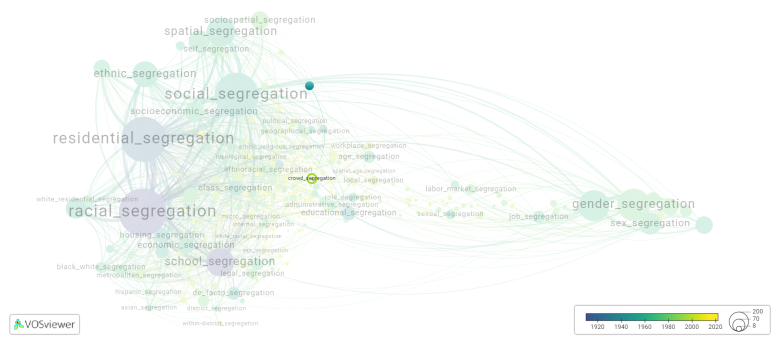Crowd segregation: Difference between revisions
(Creating page) |
(Creating page) |
||
| (8 intermediate revisions by the same user not shown) | |||
| Line 1: | Line 1: | ||
===== Date and country of first publication<ref>Date and country of first publication as informed by the Scopus database (December 2023).</ref>===== | |||
2005<br> | 2005<br> | ||
United Kingdom | United Kingdom | ||
===== Definition ===== | |||
Crowd segregation refers to the physical separation of individuals or groups in a crowd based on certain criteria such as age, gender, or security concerns. This can be done to maintain order, enhance safety, or minimize potential conflicts within a large gathering of people. For example, at a music concert, crowd segregation may involve separating sections for VIP guests, general admission ticket holders, and security personnel. | Crowd segregation refers to the physical separation of individuals or groups in a crowd based on certain criteria such as age, gender, or security concerns. This can be done to maintain order, enhance safety, or minimize potential conflicts within a large gathering of people. For example, at a music concert, crowd segregation may involve separating sections for VIP guests, general admission ticket holders, and security personnel. | ||
===== Synonyms ===== | |||
The following terms are synonymous with crowd segregation: | |||
crowd's segregation. | |||
References and literature addressing this segregation form under these synonymous terms can be found below. | |||
==See also== | ==See also== | ||
==Related segregation forms== | |||
Crowd segregation is frequently discussed in the literature with the following segregation forms: | |||
[[physical segregation]] | |||
[[File:crowd_segregation.png|780x780px]] | |||
This visualization is based on the study [[Segregation_Wiki:About| The Multidisciplinary Landscape of Segregation Research]]. | |||
For the complete network of interrelated segregation forms, please refer to: | |||
* [https://tinyurl.com/2235lkhw First year of publication] | |||
* [https://tinyurl.com/2d8wg5n3 Louvain clusters] | |||
* [https://tinyurl.com/223udk5r Betweenness centrality] | |||
* [https://tinyurl.com/244d8unz Disciplines in which segregation forms first emerged (Scopus database).] | |||
==References== | ==References== | ||
==Notes== | ==Notes== | ||
<references /> | <references /> | ||
== | {{NoteAI}} | ||
==Crowd segregation appears in the following literature== | |||
Frosdick S. (2005). Pompey v Saints: A Case Study in Crowd Segregation. ''International Journal of Police Science and Management'', ''7''(3), 149-159. SAGE Publications Ltd.https://doi.org/10.1350/ijps.2005.7.3.149 | |||
Latest revision as of 07:17, 16 October 2024
Date and country of first publication[1][edit | edit source]
2005
United Kingdom
Definition[edit | edit source]
Crowd segregation refers to the physical separation of individuals or groups in a crowd based on certain criteria such as age, gender, or security concerns. This can be done to maintain order, enhance safety, or minimize potential conflicts within a large gathering of people. For example, at a music concert, crowd segregation may involve separating sections for VIP guests, general admission ticket holders, and security personnel.
Synonyms[edit | edit source]
The following terms are synonymous with crowd segregation:
crowd's segregation.
References and literature addressing this segregation form under these synonymous terms can be found below.
See also[edit | edit source]
Related segregation forms[edit | edit source]
Crowd segregation is frequently discussed in the literature with the following segregation forms:
This visualization is based on the study The Multidisciplinary Landscape of Segregation Research.
For the complete network of interrelated segregation forms, please refer to:
References[edit | edit source]
Notes[edit | edit source]
- ↑ Date and country of first publication as informed by the Scopus database (December 2023).
At its current state, this definition has been generated by a Large Language Model (LLM) so far without review by an independent researcher or a member of the curating team of segregation experts that keep the Segregation Wiki online. While we strive for accuracy, we cannot guarantee its reliability, completeness and timeliness. Please use this content with caution and verify information as needed. Also, feel free to improve on the definition as you see fit, including the use of references and other informational resources. We value your input in enhancing the quality and accuracy of the definitions of segregation forms collectively offered in the Segregation Wiki ©.
Crowd segregation appears in the following literature[edit | edit source]
Frosdick S. (2005). Pompey v Saints: A Case Study in Crowd Segregation. International Journal of Police Science and Management, 7(3), 149-159. SAGE Publications Ltd.https://doi.org/10.1350/ijps.2005.7.3.149

